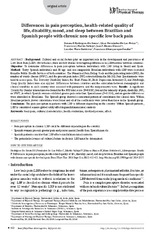Mostrar el registro sencillo del ítem
Differences in pain perception, health-related quality of life, disability, mood, and sleep between Brazilian and Spanish people with chronic non-specific low back pain
| dc.contributor.author | Rodrigues-de-Souza, Daiana Priscila | |
| dc.contributor.author | Fernández de las Peñas, César | |
| dc.contributor.author | Martín-Vallejo, Francisco J. | |
| dc.contributor.author | Blanco-Blanco, Juan F. | |
| dc.contributor.author | Moro-Gutiérrez, Lourdes | |
| dc.contributor.author | Alburquerque Sendín, Francisco | |
| dc.date.accessioned | 2023-12-19T10:08:44Z | |
| dc.date.available | 2023-12-19T10:08:44Z | |
| dc.date.issued | 2016 | |
| dc.identifier.issn | 1413-3555 | |
| dc.identifier.uri | http://hdl.handle.net/10396/26390 | |
| dc.description.abstract | Cultural and social factors play an important role in the development and persistence of Low Back Pain (LBP). Nevertheless, there are few studies investigating differences in LBP features between countries. Objective: To determine differences in pain perception between individuals with LBP living in Brazil and Spain. Method: Thirty Spanish individuals and 30 age- and sex-comparable Brazilian individuals with LBP were recruited from the Public Health Services of both countries. The Numerical Pain Rating Scale and the pain rating index (PRI), the number of words chosen (NWC), and the present pain index (PPI) extracted from the McGill Pain Questionnaire were used to assess pain. The Oswestry Disability Index, the Short Form-36, Beck Depression Inventory-II, and Pittsburgh Sleep Quality Index were also applied. Differences between countries and the correlation between demographic and clinical variables in each country were assessed with parametric and the nonparametric tests. Results: A significant Country by Gender interaction was found for the PRI total score (P=0.038), but not for intensity of pain, disability, PPI, or NWC, in which Spanish women exhibited greater pain ratio than Spanish men (P=0.014), and no gender differences were identified in Brazilians. The Spanish group showed a consistent pattern of correlations for clinical data. Within Brazilian patients, fewer correlations were found and all of the coefficients were lower than those in the Spanish group. Conclusion: The pain perception in patients with LBP is different depending on the country. Within Spanish patients, LBP is considered a more global entity affecting multidimensional contexts. | es_ES |
| dc.format.mimetype | application/pdf | es_ES |
| dc.language.iso | eng | es_ES |
| dc.publisher | Brazilian Society of Physical Therapy Research and Graduate Studies | es_ES |
| dc.rights | https://creativecommons.org/licenses/by/4.0/ | es_ES |
| dc.source | Braz J Phys Ther.; 20(5):412-421 (2016) | es_ES |
| dc.subject | Back pain | es_ES |
| dc.subject | Cultural characteristics | es_ES |
| dc.subject | Health evaluation | es_ES |
| dc.subject | Disabled persons | es_ES |
| dc.subject | Affect | es_ES |
| dc.title | Differences in pain perception, health-related quality of life, disability, mood, and sleep between Brazilian and Spanish people with chronic non-specific low back pain | es_ES |
| dc.type | info:eu-repo/semantics/article | es_ES |
| dc.relation.publisherversion | http://dx.doi.org/10.1590/bjpt-rbf.2014.0175 | es_ES |
| dc.rights.accessRights | info:eu-repo/semantics/openAccess | es_ES |

